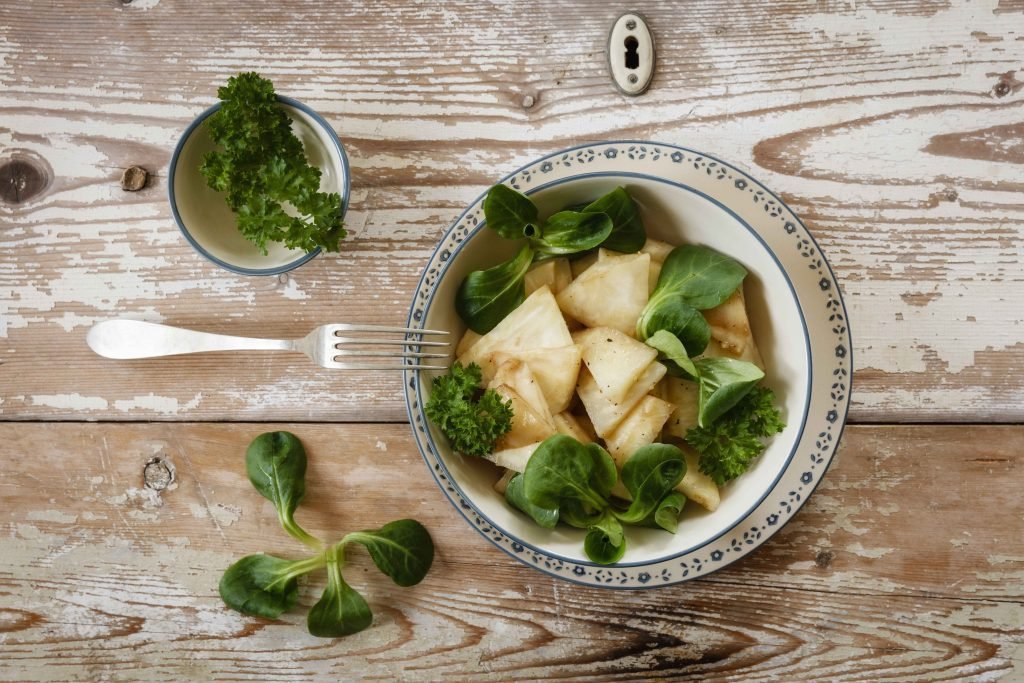Celeriac is a unique and healthy vegetable with many uses. It can provide numerous health benefits, including increasing the health of your heart and bones.
What’s Celeriac?
Celeriac is a green plant with leaves and stalks that rise above the ground. It also has roots with rough, brown skin that grows underground. Farmers grow celery to harvest its edible stalks and leaves and plant celeriac to grow its roots.
Certain people call celeriac a celery root. However, it’s not actually the source of a celery stalk.
The other names of celeriac include turnip-rooted and knob celery. It is part of the same family of plants as carrots and is related to celery, parsley, and parsnips.
“celeriac potentially boosts bone and heart health and may reduce the risk of diabetes.”
The part that is edible of the celeriac plant is its root. The inside of the plant’s root is pale and looks like a turnip or a potato. Its taste is similar to the celery or parsley. One can consume celeriac that has been washed and peeled raw or cook it with various cooking techniques.
What Celeriac is famous for
Besides these vegetables’ good taste and flexibility, celeriac potentially boosts bone and heart health and may reduce the risk of diabetes.
Bone health
Vitamin K intake can impact the health of your bones. Celeriac is a plentiful source of vitamin K, with a cup of raw celeriac offering 64 micrograms (mcg) of the vitamin.
A 2017 review of five studies that included 80,982 participants examined the relationship between vitamin K and bone fractures. Participants who consumed more vitamin K in their diets were less likely to suffer fractures.
Remarkably, the experts observed that fracture risk was lower by 22% among those with the highest vitamin K intake than those who ate the least.

Diabetes
Millions of people worldwide have type 2 diabetes, which affects the body’s ability to regulate blood sugar levels. A healthy diet can lower the chance of developing type 2 diabetes.
In a 2012 study that used data from 16154 people, Researchers looked at the relationship between the consumption of vegetables and fruits, which included root vegetables, and the risk of developing diabetes of type 2 diabetes.
They discovered that people who consumed the highest amount of root vegetables had a risk of developing diabetes 13% lower than people who ate the smallest amount.
That means Eating vegetables provides numerous health benefits due to their rich nutrient content, and they are packed with essential vitamins, minerals, and dietary fiber.
Raw celeriac is no exception. It could provide many potential advantages for individuals living with diabetes. Here’s how it might work:
1. Low Glycemic Index:
Celeriac has a low glycemic index, meaning it causes slower and more gradual rises in blood sugar than high-glycemic foods, which can help manage and avoid sudden spikes.
2. High Fiber Content:
Celeriac contains high amounts of dietary fiber, making it an excellent way to help regulate blood sugar levels. By delaying digestion and absorption of carbohydrates after meals, fiber prevents sudden spikes or drops in blood sugar.
3. Nutrient Density:
Celeriac contains essential vitamins and minerals, such as vitamin C, potassium, and magnesium, that contribute to overall health benefits and help individuals living with diabetes by supporting insulin function and decreasing risks associated with complications.
“High blood pressure can be the leading reason for stroke and cardiovascular diseases.”
4. Weight Management:
Celeriac is low in calories, making it a practical addition to a weight management plan for individuals with diabetes. Achieving and maintaining a healthy weight is crucial as it can improve insulin sensitivity while helping manage blood sugar levels.
Heart health
In a 2015 study that involved 2884 adults, researchers studied the relationship between the level of plasma ascorbic acids, a measure of vitamin C in the blood, and an individual’s likelihood of high blood pressure.
The researchers found that those who had higher blood amounts of ascorbic acid were at lower risk for developing hypertension.
Nutrition facts
Consuming foods rich in vitamin C, like celeriac, can help reduce the risk of developing high blood pressure by increasing the level of ascorbic acids in their bodies. High blood pressure can be the leading reason for stroke and cardiovascular diseases.
As per the United States Department of Agriculture (USDA), one cup of raw celeriac contains:
65.5 calories
2.34 grams (g) of protein
0.47 g of fat
14.40 grams of carbohydrate
2.81 grams of fiber
Celeriac is a rich source of numerous nutrients. It is a rich source of many nutrients, including:
vitamins C/ K / B6
potassium
Phosphorus
Fiber
Celeriac is particularly rich in vitamins C and K, and It could contribute significantly to the recommended daily intake.
“A cup of cooked celeriac has 42 calories versus 134 calories coming from a cup of cooked potatoes”
some Celeriac-based dishes
Celery Root is a versatile and tasty ingredient in soups, mashes, side dishes, and salads.
If celeriac isn’t ready in the market, people can use celery and parsley roots to get similar flavors in soups. When roasting or mashing, parsnips or potatoes could be an ideal substitute.
The majority of people cook celeriac and potatoes with similar methods. It is also possible to use one instead of the other in dishes, So it can be used as an alternative to potatoes for people who want to reduce calories or carbohydrate consumption.
According to the USDA, a cup of cooked celeriac includes 42 calories and 9.14 grams of carbohydrates. Similar amounts of cooked potatoes give 134 calories and 31.2 grams of carbohydrates.













